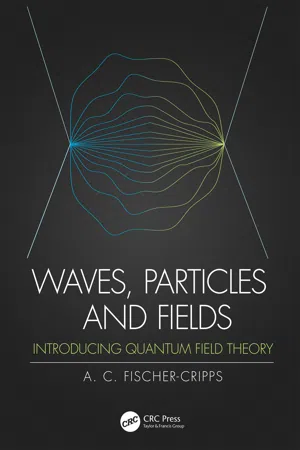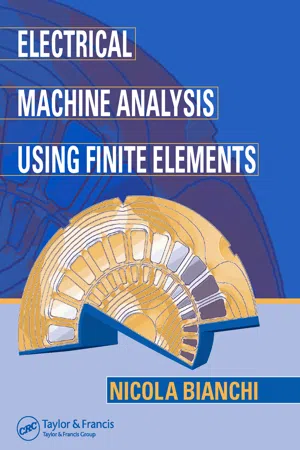Physics
Electromagnetic Field Tensor
The electromagnetic field tensor is a mathematical construct used in the theory of electromagnetism to describe the electromagnetic field. It combines the electric and magnetic fields into a single object, providing a more elegant and concise way to express the laws of electromagnetism. The tensor is a key concept in understanding the behavior of electromagnetic fields in both classical and quantum physics.
Written by Perlego with AI-assistance
Related key terms
Related key terms
1 of 4
Related key terms
1 of 3
3 Key excerpts on "Electromagnetic Field Tensor"
- eBook - ePub
Waves, Particles and Fields
Introducing Quantum Field Theory
- Anthony C. Fischer-Cripps(Author)
- 2019(Publication Date)
- CRC Press(Publisher)
1515.1 Introduction
The electric field E and the magnetic field B at a point are, in general, functions of t , x , y , z .E=Et , x , y , z )B=Bt , x , y , z )(15.1) That is, at every point in space (x , y , z ) there may be an electric and/or a magnetic field. Both the E field and the B field are vector fields. In the case of the electric field, the vector points in the direction in which a positive test charge would move if placed at that point. In the case of the magnetic field, the direction of the vector is perpendicular to the direction of motion of the test charge and the direction from which the force acts upon the test charge by the right-hand rule. The magnitude of each field is usually written as E and B . Both magnitude and direction of the E and B fields may be a function of time as well as position.When fields vary with time, the change in magnitude or direction can be determined by taking the derivative of the function that describes the field. That is, the gradient. We might take the derivative with respect to time, or with respect to a direction – a spatial rate of change of a function. The value of a field may change at a different rate depending on which direction the derivative is taken. The spatial derivative can be found from the differential operator∇.In this chapter, we deal with the electromagnetic field which is either stationary or moving with a constant velocity. The electric field arises from the presence of a charged particle. The magnetic field arises from the uniform motion of a charged particle. It is only when we have an accelerated charged particle that we obtain an electromagnetic wave - eBook - ePub
- Levent Sevgi(Author)
- 2014(Publication Date)
- Wiley-IEEE Press(Publisher)
CHAPTER 6 Electromagnetic Theory: Basic ReviewElectromagnetics (EM) has increasingly gained attention for the last decade or so parallel to widespread usage of wireless systems; therefore (as proposed by my colleagues and dear friend Professor Anton Tijhuis from the Netherlands), we have to replace the motto Engineering Electromagnetics with Electromagnetic Engineering. This replacement also necessitates full review of electrical engineering education. EM engineers today should be well equipped with theory as well as practice including the classical EM field theory, wave scattering, antennas, circuit theories, transmission line theory, and microstrip circuits. Modern topics such as radar systems and wireless communication necessitate a good understanding of signal processing techniques together with deterministic and stochastic methods. This chapter roughly brings together fundamental EM concepts, mathematical relations, and physical meanings.6.1 Maxwell Equations and Reduction
Any EM problem may be postulated in terms of Maxwell equations via(6.1a)(6.1b)where the vectors used are , electric field (V/m); , electric flux density (C/m2 ); , magnetic field (A/m); and , magnetic flux density (Wb/m2 ).The theory behind EM fields is well established by Maxwell equations. The parameters σ, ε, and μ (non-negative real numbers) are used as constitutive parameters of the medium under interest, where σ is conductivity (S/m) (models losses dissipated as heat), ε is permittivity (dielectric constant) (F/m) (models E-field storage capability), and μ is permeability (magnetic constant) (H/m) (models H-field storage capability).A medium is called to be “simple” when it is homogeneous (constitutive parameters do not vary with position), linear (constitutive parameters are not functions of applied/external EM fields), and isotropic (constitutive parameters are not functions of directions of applied/external fields). In a simple medium, EM vectors are related to each other and also to the excitation current density as - Nicola Bianchi(Author)
- 2017(Publication Date)
- CRC Press(Publisher)
B . This force is called Lorentz’s force and will be described hereafter.The fundamental property of the field B is that it is a solenoidal field, i.e., the flux of B through any closed surface Sc is null. Thus, it isd iv B = 0( 1.65 )in differential and integral forms, respectively.∮B · n d S = 0S c( 1.66 )1.2.5 Vector Magnetic Potential Field
Since the magnetic flux density field B is solenoidal in the whole space, it is suitable to define a vector magnetic potential field A , whose magnitude is measured in (Tm), such asB = curl A( 1.67 )This relationship defines the field A apart from a generic irrotational field. The divergence of A can be defined in an arbitrary way; the positions that are commonly adopted are as follows.Coulomb’s position , mainly used in stationary or quasi-stationary magnetic fields and also used in the book:div A = 0( 1.68 )Lorentz’s position , which is well suited in the study of rapidly time-variable electromagnetic fields:div A = - μ ɛ∂ V∂ t( 1.69 )1.2.6 Magnetic Field Strength
Together with the flux density vector B , the magnetic field strength vector H is introduced. The measure unit of its magnitude is (A/m). The two vector fields are linked by the constitutive lawB = μ H( 1.70 )where µ (H/m) is the magnetic permeability of the medium. Within an uniform medium the two fields B and H are proportional (i.e., they have same direction and proportional magnitude), while in an anisotropic medium their link exhibits a tensorial nature.The fundamental property of the field H
Index pages curate the most relevant extracts from our library of academic textbooks. They’ve been created using an in-house natural language model (NLM), each adding context and meaning to key research topics.
Explore more topic indexes
Explore more topic indexes
1 of 6
Explore more topic indexes
1 of 4


